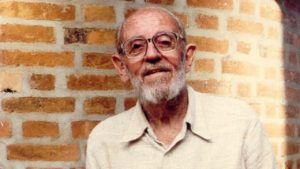
Laurie Baker
Meeting Gandhiji
Born in England, Laurie Baker (1917-2007), a British Architect, worked during World War II in an ambulance unit in China, Japan and Burma. When he was in India sometime in the early 1940’s, he had a chance encounter with Mahatma Gandhi, which changed his life. In 1945, he came to India to design buildings for leprosy missions. He lived and died here.
When he first came to work in India, Baker and his Indian wife Elizabeth lived among the poor in Pithoragarh for 16 years. During this period, the simple, efficient and inexpensive methods used by the poor people to construct their homes had a profound influence on him. His realized the importance of using local materials, taking into account local climate patterns and accommodating the local social pattern of living. He worked with and learnt from mountain tribes and village masons using indigenous materials for building. He built schools, hospitals, and community buildings.
In 1963, the Bakers moved to Kerala (Elizabeth’s state), where he evolved methods for using mud, employing discarded Mangalore tiles for reducing the amount of concrete in roofs, avoiding plastering of walls etc. Then followed a series of houses, buildings and campuses. He evolved a unique style that came to be called the Baker style of architecture with its distinct mud-block walls.
Baker undertook a wide range of projects in India from fishermen’s villages to institutional complexes and very low-cost mud-housing schemes to low-cost cathedrals. Most of his work was located in Kerala, where he lived for many years (in Thiruvananthapuram). He designed more than 1000 houses, over 40 churches, school buildings, institutions (like the Centre for Development Studies), hospitals and low-cost housing schemes. He also helped in designing and building new houses in quake-ravaged Latur. He was the principal architect of “Dakshinachitra”, a centre for the preservation of arts, crafts and architecture of the southern states, located on the East Coast Road near Chennai.
Hundreds of architects came to learn from him and his ideas have spread all over India and to other countries too. He established COSTFORD (Centre of Science and Technology for Rural Development), an organization to promote low-cost housing. Baker also wrote simple books on design – handwritten with his own illustrations.
In 1988 Baker became an India citizen and in 1990 he was awarded the Padmashri. He was honoured by the Royal University of the Netherlands and was conferred the MBE by the Queen of England. Active until the end, he died in 2007.
In his book on Baker, architect Gautam Bhatia writes, “Nature is transcendent in his work. He uses it to create stunning effects. A pool of water, a patch of shade, sunlight marooned in shadows, a clump of bushes, a wild tree – it is all grist for his mill”.
Baker himself described his approach in this way: “I learn my architecture by watching what ordinary people do; in any case it is always the cheapest and simplest because ordinary people do it. They don’t even employ builders, the families do it themselves. The job works, you can see it in the old buildings-the way wood lattice work with a lot of little holes filters the light and glare. I’m absolutely certain that concrete frames filled with glass panels is not the answer.”
Afterword: I became interested in the Baker style many years ago and helped a rural NGO in Tamil Nadu to construct a training complex with the help of COSTFORD. Later, Chitra Vishwanath, an ecological architect in Bangalore, designed a Baker-style house for me in which I lived for 16 years. I can truly say that it is a special experience living in a Baker house.

I have been constantly interacting wit Prof. Jagdeesh (IISc, Retired), Bangalore, on the mud brick technology, who is a pioneer in this area of work. He has created many students who are all working on this technology both in the urban and rural spaces as a part of their individual ventures. I am associated with NIVASA a NGO that is working on low cost housing projects, using local materials. ‘Nivasa is an Architectural Not for Profit Trust, working to enable humane and dignified housing conditions for the urban and rural poor, through design’ (from its website). The founders are associated with Navadarshanam as well. They are a group of people sacrificing their time and efforts for a public cause. Anyone interested may donate to their noble cause, which will help them to construct houses for the have not.